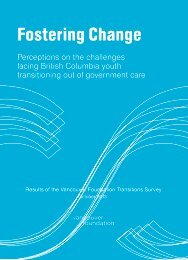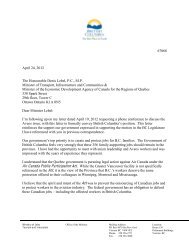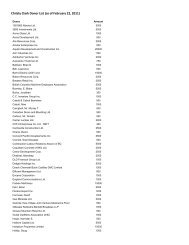from the ground up - The Tyee
from the ground up - The Tyee
from the ground up - The Tyee
You also want an ePaper? Increase the reach of your titles
YUMPU automatically turns print PDFs into web optimized ePapers that Google loves.
Beyond rebatesOne thing is clear: it will take more than rebates. AsChristopher Pollon reported previously in this series,rebates like <strong>the</strong> SmartEnergy program add <strong>up</strong> to just adrop in <strong>the</strong> bucket.In December, Mayor Gregor Robertson announced <strong>the</strong>city was developing a pilot program that would allowhomeowners to pay for home energy retrofits throughon-bill financing.On-bill financing means <strong>the</strong> homeowner doesn’t haveto dip into savings and pay a lump sum <strong>up</strong> front, andit’s more convenient than asking a person to go to abank and take out a separate loan. It’s easier to trackas <strong>the</strong> cost of running a household, too. Retro-fit loancharges can be folded into tax or utility bills <strong>the</strong> residentis already paying.“We want to make it easy for everyone so you can optin and you pay over time but <strong>the</strong> cost is offset by <strong>the</strong>savings in energy,” Robertson said when he launchedVancouver’s version.<strong>The</strong> program will allow a homeowner to borrowmoney to finance home energy retrofits -- things likenew furnaces and boilers, more efficient windows,insulation and wea<strong>the</strong>r stripping. That loan can <strong>the</strong>nbe repaid over time on <strong>the</strong> homeowner’s property tax.This kind of long-term, low-interest financing modelis already being adopted many U.S. jurisdictions,including Portland. Two years ago, it launched CleanEnergy Works Portland, a pilot similar to <strong>the</strong> one Vancouveris proposing, which has reached 500 homeownersin <strong>the</strong> city.Moving energy savings to a top priorityMarlowe Kulley is a clean energy specialist with <strong>the</strong>city who helped develop and implement <strong>the</strong> pilot. Oneof <strong>the</strong> biggest challenges, she explains, was convincinghomeowners that energy retrofits were something<strong>the</strong>y want, or ought, to do.“Most people would like to save energy at <strong>the</strong>ir home,but it’s not necessarily at <strong>the</strong> top of <strong>the</strong>ir list of projects,”Kulley says. “Especially when you think abouto<strong>the</strong>r home improvement projects <strong>the</strong>y might do -- abathroom remodel, or a new addition.”To combat this, Clean Energy Works Portland didwidespread advertising, but also targeted outreachin one particular neighbourhood -- <strong>the</strong> Cully neighbourhood-- in a working class part of <strong>the</strong> city. <strong>The</strong>ycontracted a team who canvassed door to door, heldneighbourhood potlucks and approached peoplethrough local churches and community centres. Accordingto Kulley, approximately 2,300 people responded.Those who qualified for <strong>the</strong> program first received avisit <strong>from</strong> a home energy auditor to assess energy useand potential savings. <strong>The</strong>n, <strong>the</strong>y got an estimate ofwhat work needed to be done and how much it wouldcost. If <strong>the</strong> homeowner decided it was worth it, <strong>the</strong>ysigned <strong>the</strong> loan agreement and work began.<strong>The</strong> average loan through this pilot program is$12,600, with a 20-year fixed interest rate of 5.99 percent (residents who qualify for federal income assistanceget a 3.99 per cent interest rate). <strong>The</strong> averagepayment per month is $76 per month, but combinedwith lower utility bills, real costs are more like $25per month.Through <strong>the</strong> whole process, Kulley and <strong>the</strong> team atClean Energy Works Portland guided homeowners.This is key, according to Eric de la Place, a senior researcheron climate and energy policy at <strong>the</strong> SightlineInstitute.“Even if you’ve got $10,000 in hand to do energyefficient<strong>up</strong>grades, how do you spend it? It’s hardfor <strong>the</strong> average person to determine <strong>the</strong> right investments,”he says. “We’ve been advocating for an energyconcierge for municipalities -- someone to helpyou do energy audits, tell you about <strong>the</strong> return, hireout contractors, have <strong>the</strong> work done and do a postworkaudit.”Kulley measures <strong>the</strong> program’s success in part by itsconversion rate; that is, <strong>the</strong> number of people whoreceived an energy audit and actually went on to geta loan and do <strong>the</strong> work. Clean Energy Works has a 66per cent conversion rate. In a free market, without <strong>the</strong>benefit of an on-bill financing program, that number ismore like 16 to 20 per cent, according to Kulley.75








